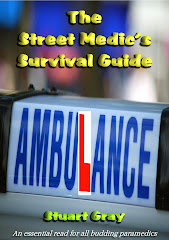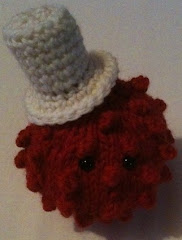I had an observer with me on my clinical mission today – a driving instructor who wanted to see what the difference was between the tidy lesson-method and the only way to get around on blue lights in London town. She had a thoroughly good day by her own account.
A 15 year-old insulin-dependant female was the recipient of my first visit of the morning; she’d left hospital in the early hours without taking a new batch of insulin with her and I was to taxi her back to get it. When I got into the little flat, Gran was moaning about her and she was cooking food while her teenage mate slumped on the sofa looking very uninterested.
‘I don’t need to go back to hospital’, she told me. She spoke with that new-south-London accent that teens, especially white girls, use; it’s a kind of pseudo-black popular twang that I find very annoying to listen to – it smacks of I don’t care.
I checked her BM and she showed me that her insulin was in the fridge. Gran looked powerless and a little nervous to be honest. This was not a cosy little family and I’m convinced the girl and her mate had been out all night. She probably ended up in A&E drunk and the insulin was a side-issue. Gran’s place was very likely the reasonable excuse for not being at home all Friday night.
That was followed later on by a drug addict who wandered into a tourist shop and promptly fell, hitting is head and causing mild panic. A police officer was on scene when we got there and she explained that she was asked to help him when he tumbled.
The man looked stoned to me – tiny little pupils and hardly awake – he had to be prodded back into life regularly; a sure sign that he was on something. He denied this of course. A police officer was there, so of course he denied it.
As I collected information from him and checked his obs, the store Manager (he looked like a manager) tried to get him to stand up and leave the shop because he was (a) in the way on the steps and (b) untidy looking and therefore bad for business. I asked him to be patient and walked the addict out of the shop and onto the back seat of my car, where he tried, again and again, to become unconscious.
The crew arrived as other cops landed to help out and I handed the man over for Narcan and a quick trip to A&E. I was told that he was a Misper (missing person) – he’d been reported missing by his friend, who was elsewhere worrying about him.
I managed to find out that the patient had met someone and wandered off with him, probably to get the drugs he now had in his blood. This is typical behaviour and so his mate shouldn’t really have been worried about it.
While the crew was dealing with him in the ambulance, the police officers were asked to assist with something across the road and out of my vision. A few minutes later, I was asked to help someone who was fitting in the street. This is where the cops had been taken and I crossed the road to find them trying to hold down the man as he seized on the pavement. A small crowd had gathered around him but the place was heaving anyway, so people were going to be an obstruction, no matter what.
A few more cops arrived and another FRU pulled up to assist. My driving instructor observer helped out too; she became an expert at getting certain bits and pieces for me by the end of the shift.
It took a couple of minutes to change the status of the young man on the pavement – a bit of oxygen was required. He stopped fitting and became agitated and confused, which is pretty much par for the course. Another ten minutes went by as we asked him questions and tried to ascertain his medical history – he wasn’t epileptic and I suspect that he’d probably taken something. He’d been out all night.
An awkward job next; a woman fell down a set of steep steps in a shop. She didn’t see the first step and simply tumbled, head-over-heels until she hit the bottom with her head. She had two nasty bumps on her cranium. She hadn’t been knocked out and there was very little blood around but she’d come down at a high angle and must have hit hard when she landed, so I asked for a crew to bring a spinal board down.
Unfortunately, taking her out on the board wasn’t going to be safe, for her or the crew, so we collared her and made use of the chair while she was still in a sitting position. At the top of the steps, she was transferred onto a board and strapped in securely. She had no neurological deficit and no neck pain or tenderness. Her status didn’t change during the lift up the stairs. It was all precautionary.
Another 15 year-old girl, this time with less attitude, and a normal accent, albeit American, was waiting for me at a tube station. She’d collapsed after being sick into a bag – she felt generally unwell and it may have been down to something she’d eaten. I put the blame on ice cream.
Her mum, dad and older sister were with her and everyone seemed happy enough. I spoke to her while we waited for the ambulance and I chatted to her parents and her sister (who is very nice and apparently doesn’t bully her sibling) while still waiting for an ambulance.
Eventually, after being told that it was ‘on scene’ but not seeing a crew appear, I walked the girl and her family to the car. There was no ambulance outside. They were at a completely different station. It made more sense to take her in the car now.
Big sister and dad walked across the bridge to the hospital and I drove the patient and her mum but, as the direct result of paperwork, I was beaten to the hospital by the walking party. So now the people of Colorado think the London Ambulance Service is slower than a snail in a headwind. Not true though… ask the driving instructor!
The young lady was left in the gentle care of the paediatric nurses and her family waited with her. I said goodbye and left for the next mission. Before I finished this call however, I made enquiries on behalf of the young lady. So, just for you and because you didn’t know – your name means ‘Towers’.
The shift ended with another fitting. This time we had to run and descend deep into the underground to get to the patient. It was busy with people of course and not many of them cared to move out of the way so that we could reach the platform quickly. A tannoy announcement had been made just as we arrived, informing passengers of a medical incident but it made no difference to the people who were obstructing us by standing in the middle of the escalator.
The lady was with her family and friends; she had been fitting on the train and was taken off to recover on the platform. She was very confused and very strong, as she thrashed and lashed out when I tried to give her oxygen. This was to be expected and I won’t fight with someone in that condition, so the mask was left off until she was a little less combative.
The crew was on scene soon after I’d started my obs and the woman was less agitated by the time she was placed into the chair for the long trip up to street level.
I have a few more shifts on the road coming up, so I’ll report as and when. In the meantime I’ll continue to comment on the issues that make a difference to us here.
Be safe.
Subscribe to:
Post Comments (Atom)















6 comments:
So the surname was Torres?
Yes but before everyone gets all excited, I asked for permission to recount this story. I usually do.
:-)
Xf - how exactly do you ask permission to recount it? Is it a case of, 'oh by the way, I have a blog.....'? Do many people refuse?
Keep up the good work, both on the streets and on the blog!
Northern monkey
Pretty much. If I'm engaged in conversation and the patient isn't too ill and there is a rapport, I will simply tell them that I record my calls in a blog. I let them know that I won't identify them but most people don't mind at all.
no diazepam for the fitters?
Anon
In both cases the fits resolved. Diazepam would only be given if more fits were anticipated and even then we'd try to get them onto an ambulance first as it is given rectally in emergencies. IV can be difficult to say the least when they are fitting.
Post a Comment